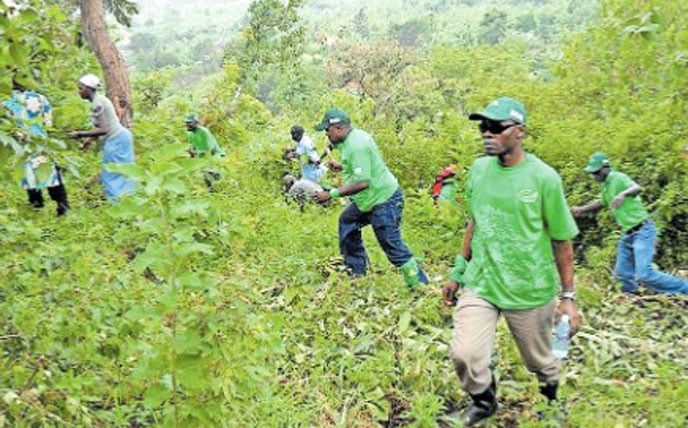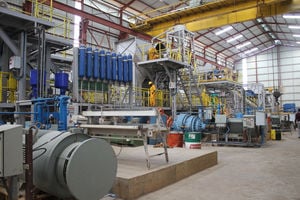Community-led restoration efforts upholding Budongo Forest

Mr Moses Kasumba and other members of Budongo Youth Conservation Group, a local initiative launched in 2022 to combat deforestation beside a patch of newly planted trees. PHOTOS | ISMAIL BATEGEKA
What you need to know:
Currently, Uganda’s forest cover stands at 12.4 percent up from nine percent in 2017. Although this increase is exciting news, deforestation still remains a great challenge. Now, though, communities living near central forest reserves, like Budongo Forest, are taking part in replanting and conservation efforts as Ismail Bategeka writes.
Once in the grip of devastation due to illegal logging, charcoal burning and encroachment, Budongo Central Forest Reserve is now witnessing a remarkable restoration as local conservation efforts go a notch higher. Budongo Forest, which is managed by the National Forestry Authority (NFA), covers parts of Hoima and Kikuube districts. Previously, the forest, which is a catchment area for Lake Albert, was well known for its mahogany trees and the high population of chimpanzees.
Made up of six forest blocks – Siba, Waibira, Busaju, Kaniyo-Pabidi, Biiso, and Nyakafunjo – the forest has faced continuous pressure from crop farmers seeking more land, illegal loggers, hunters, and charcoal burners. Some parts of the forest were cleared to plant sugarcane and tobacco. At the heart of this transformation are two driving forces: youth-led reforestation projects and women’s empowerment through sustainable livelihoods. These grassroots movements, which have chosen to safeguard their environment while creating sustainable economic opportunities for their communities, are revitalising the forest, offering hope for the future of one of Uganda’s largest tropical rainforests. One tree, one livelihood at a time.
Moses Kasumba stands proudly beside a patch of newly planted trees in Busingiro village, just outside Budongo Forest. It is a warm afternoon, and his hands, calloused from planting saplings, tell the story of months spent working alongside fellow youth to restore areas of the forest lost to deforestation. “We started with a small group of ten, but now we are 50 youths, and our goal is to replant over 50 hectares of forest by the end of the year. We have already covered 20 hectares, and it is amazing to see how the community has embraced this project,” Kasumba says.
The 23-year-old is part of Budongo Youth Conservation Group, a local initiative launched in 2022 to combat deforestation by engaging the region’s youth in tree-planting campaigns. Each of the group members contribute Shs2,000 to Shs3,000 every month to fund their environmental programs such as training local youths and buying tree seedlings and tools. Edward Rusenjule, the chairperson of the group has praised the efforts of local communities, especially the community forest management groups, in safeguarding the Budongo Forest.
“These community groups are actively involved in conducting regular patrols within the forest to curb illegal logging, charcoal burning, and other activities that threaten the forest's health. The groups are also closely monitored to ensure they adhere to conservation guidelines but we need more support from both government and non-governmental organisations,” he says.
Efforts to conserve the forest are vital not only for preserving biodiversity but also for maintaining the livelihoods of surrounding communities that rely on its resources.
Betty Tumushabe, a 19-year-old member of the group, explains how the reforestation effort has brought more than just environmental benefits. “Planting trees has given us a sense of responsibility. We are not just helping the forest; we are also creating an income for ourselves. When the trees we have planted mature, we sell some of them off as timber and use the proceeds to fund school programs that teach children about conservation,” she says.
Tumushabe’s excitement shows that the project does not only restore the local environment but it will also secure a future where nature and livelihoods exist harmoniously. Meanwhile, in the village of Kapeeka, just a few kilometers from Budongo Forest, a group of women sit around beehives. Among them is 35-year-old Amina Nakato, the leader of the Kapeeka Women’s Empowerment Group, which is working to promote sustainable livelihoods through eco-friendly practices like beekeeping and mushroom farming. “The bees are our treasure. We harvest the honey and sell it in Masindi town.
The money we make goes towards supporting our families, and we no longer need to cut down trees for firewood or charcoal. It is a way to live sustainably,” Nakato says. The group, formed in 2021, grew from five women to over 30 today, and has received training from non-governmental organisations such as Tree Talk Plus and Budongo Conservation Field Station.
These organisations provide technical skills assistance, helping the women establish income-generating activities that lessen their dependence on forest resources. Sarah Bwambale, another member of the group, proudly shows off her mushroom farming venture, the skills of which she learned in the group’s training sessions.

Betty Tumushabe’s excitement is shared by her peers.
“Mushroom farming has changed my life. It does not take up much space, and the demand for mushrooms is quite high at the local markets and in the hotels. The waste from the mushrooms makes organic fertiliser for our gardens,” says the 40-year-old.
Both Nakato and Bwambale are proof that sustainable livelihoods do not only empower women economically but also help reduce the community's reliance on destructive activities like logging. Their efforts, backed by conservation organizations, have created a ripple effect, with more women joining the group to adopt these practices.
The results of these initiatives are already visible in the community as the youth-led reforestation projects in areas that had been cleared for illegal logging now boast young forests that are slowly recovering. Looking to the future, the youth and women groups have ambitious plans.
Kasumba says his group’s target is to partner with schools in Masindi and Buliisa districts to establish tree nurseries. “We also want to educate the students about forest and animal conservation. If we can teach the next generation to care for the forest, we can ensure its survival for years to come,” he explains. For the women’s group, their goal is to expand their honey production and establish a cooperative society to sell honey and mushrooms to a larger market.
“We want to reach bigger markets in Kampala City and beyond. With the skills we have gained, the sky can only be the limit,” Nakato says. The journey to restoring Budongo Forest is far from over, but with the youth and women at the forefront, the future looks promising. Their efforts are a powerful reminder of how grassroots action can create real change, benefiting both the environment and the people who depend on it.
The challenges
Samuel Tibenderana, a member of Budongo Community Volunteers Tree Planting Association says challenges remain in replanting and restoring the vital tree species, especially mahogany, in the tropical rainforest.
“Recent studies indicate that there is a pressing need to revisit replanting strategies to ensure the forest’s sustainability. Two critical findings have emerged from research conducted in heavily treated forest areas. First, despite efforts, mahogany trees have not shown an increase in stem density or basal area,” he says.
The basal area is the area covered by tree trunks in these regions. Tibenderana adds that it has been observed that mahogany trees only begin producing fruit when they reach a larger tree size. “This is a natural limitation that impacts their ability to regenerate. These findings suggest that current-replanting efforts may not be as effective as hoped. In the 1950s, attempts to replant mahogany seedlings were abandoned due to poor success rates and prohibitive costs,” he says.
Since then, some trial plots have been established to experiment with the replanting of saplings rather than seedlings. However, these trials have not been extensively revisited, leaving a significant gap in understanding the most effective strategies for replanting mahogany trees in Budongo Forest. Forestry experts are now recommending that the replanting plots be reinvestigated to evaluate the success of different methods. Specifically, further research is needed to determine whether planting larger saplings rather than seedlings may yield better results.
Dr Patrick Kanyankore, a forest conservation specialist, says this research could potentially open new pathways for more efficient and sustainable reforestation practices. "Replanting strategies that consider the natural growth patterns of mahoganies, such as their fruiting size and ability to thrive in various conditions, are essential. We cannot afford to lose such an important species because we lack sufficient knowledge on how best to restore it," he says.
The rationale
Some conservationists also suggest that incorporating indigenous knowledge, alongside scientific research, could help identify replanting methods that align with the natural conditions of Budongo Forest. These efforts could also serve as a model for other reforestation initiatives across Uganda and the wider East African region.Budongo Forest is not only home to mahogany trees but also plays a crucial role in biodiversity conservation, housing a wide variety of wildlife, including chimpanzees and bird species. With ongoing threats from deforestation, agricultural encroachment, and illegal logging, the urgency to develop successful replanting techniques is greater than ever.
Budongo Forest is one of the natural forests in the Albertine Rift in the Bunyoro sub-region. Since Uganda intends to start commercial oil exploration in April 2025, the high rates of deforestation in the region are causing alarm because natural forests will be needed to manage carbon emissions arising from the oil exploration activity. It is against this background that early this year, district councils in the Albertine Rift have consented to a proposal that will see forests gazetted as national game parks, under Uganda Wildlife Authority (UWA). Some environmentalists believe that UWA, which depends on armed rangers directly under its employ and the army to sustain its conservation efforts, is in a better position to protect Uganda’s forests.
BUDONGO FOREST
The Budongo Forest in Uganda is northwest of the capital city Kampala on the way to Murchison Falls National Park and is located on the escarpment northeast of Lake Albert. It covers parts of Hoima and Kikuube. It is known for its former abundance of East African mahogany trees as well as being home to a population of chimpanzees. The forest covers 82,530 hectares and is a catchment for Lake Albert. It is managed by National Forestry Authority (NFA). Four streams, Waisoke, Sonso, Kamirambwa and Siba, drain the forest and flow into Lake Albert. Annual rainfall in the area is between 1200 and 2200 mm, the rainy season being from March - May and again from September - November, the dry season being December - February. It is made up of six forests.
The nearest town is Masindi, and much of the land around the forest is given over to crops, dwellings and villages, placing continuous pressure on the forest margins, and leading to exploitation for building materials and bushmeat, the snares set by poachers causing mutilation of the chimpanzees and other animals. Some of the human activities carried out include; charcoal burning, illegal logging, poaching, mining and unsustainable agriculture such as rice farming. Some parts of the forest has been cleared to plant sugarcanes and tobacco.




